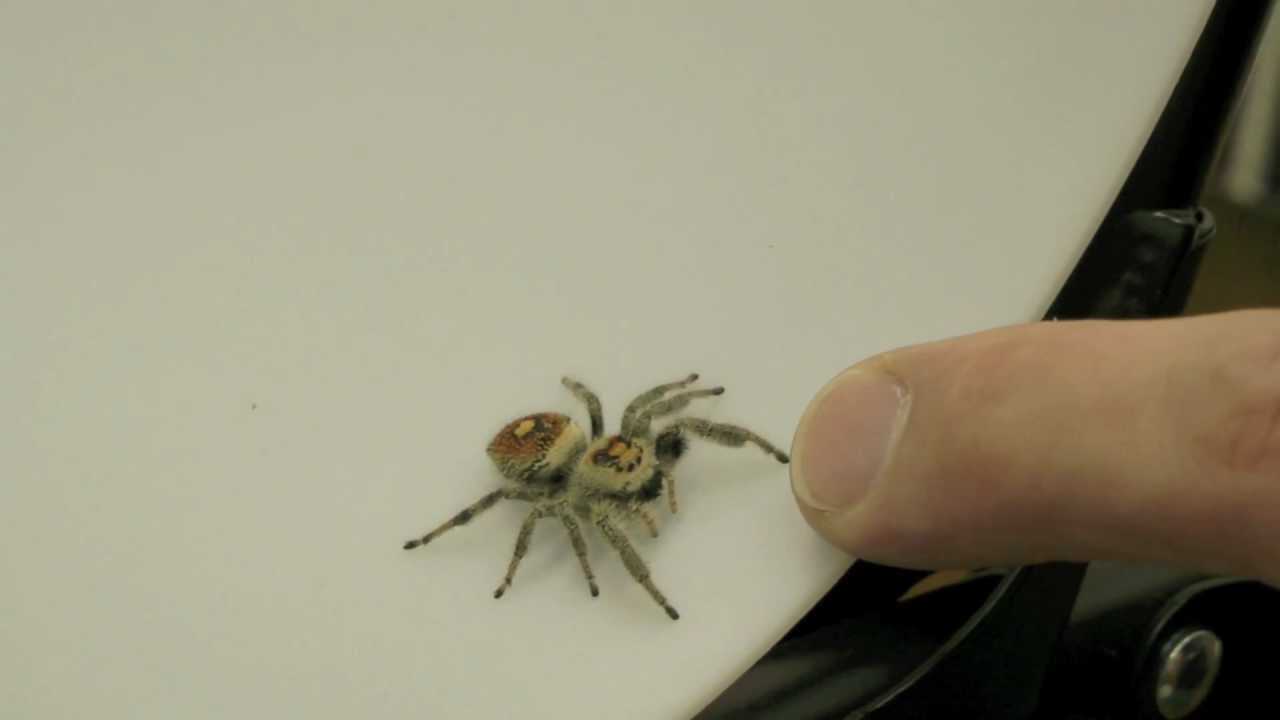
These vibrant creatures vary in colors, with males exhibiting more intense hues compared to their female counterparts. The brightly colored markings on their bodies serve multiple purposes, including camouflage, attracting mates, and warning potential predators. Their attractive appearance makes them a popular choice for spider enthusiasts and photographers alike.
The regal jumping spiders can be found in various habitats, including forests, grasslands, and even urban areas. These versatile creatures are skilled hunters and primarily prey on small insects, such as flies and moths. Their astonishing leaping ability allows them to ambush their prey with precision, making them formidable predators in the insect world.
Average Size of Regal Jumping Spiders
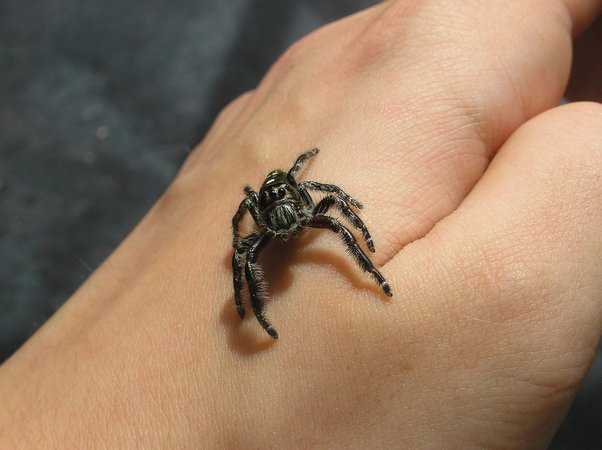
On average, regal jumping spiders tend to have a body length ranging from 10 to 20 millimeters, with males usually being slightly smaller than females. Their leg span can reach up to 50 millimeters, making them relatively large compared to other jumping spider species.
| Species | Average Body Length (mm) | Average Leg Span (mm) |
|---|---|---|
| Phidippus regius | 10-20 | Up to 50 |
| Other Jumping Spiders | Varies | Varies |
The size of a regal jumping spider can be influenced by the availability of prey in their habitat. In areas with abundant insect populations, these spiders have been observed to grow larger. This suggests that the availability of food plays a role in their overall size.
Factors Affecting Regal Jumping Spider Size
Habitat
The habitat in which regal jumping spiders live plays a significant role in determining their size. Different habitats provide varying amounts of resources such as food and shelter, which can directly impact the spider’s growth. In general, regal jumping spiders found in rich and diverse habitats tend to be larger in size compared to those in less favorable environments.
Prey Availability
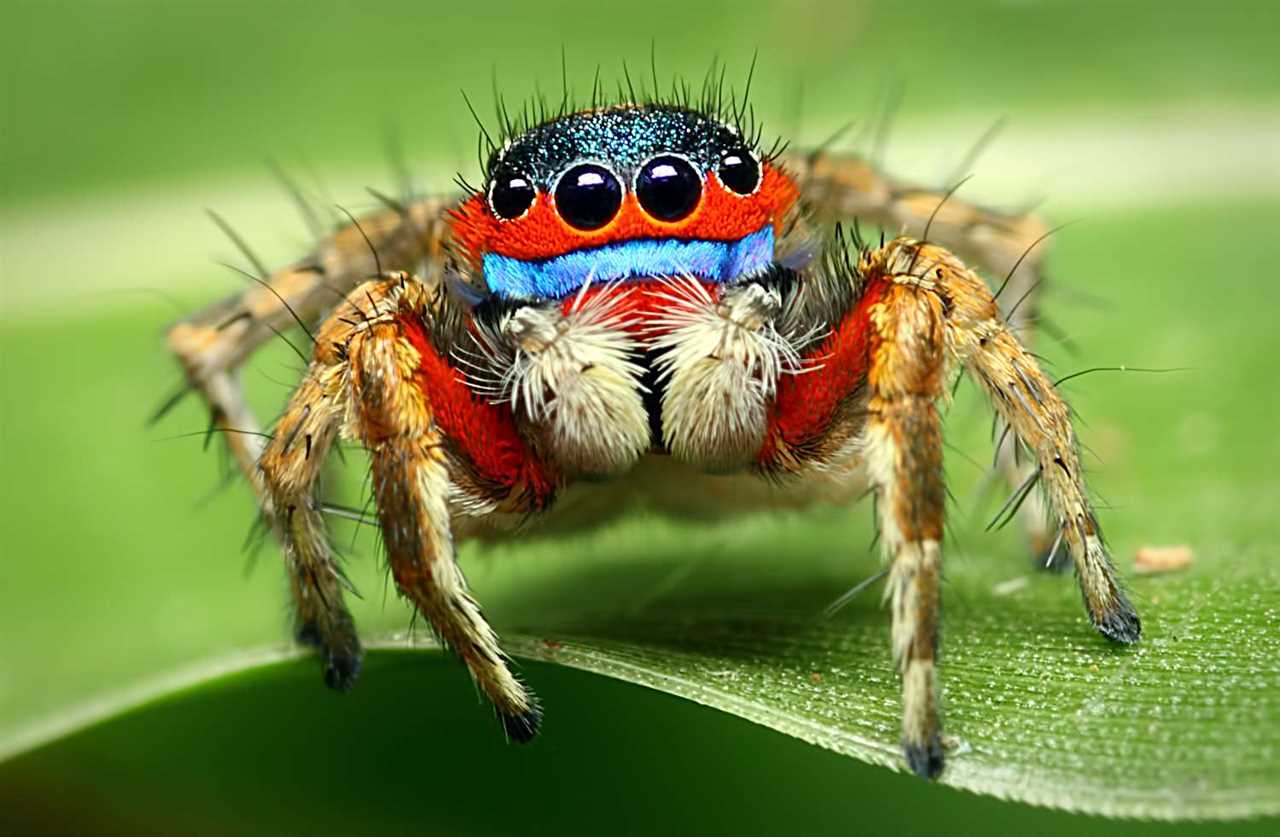
The availability of prey also plays a crucial role in determining the size of regal jumping spiders. These spiders primarily feed on insects, including flies, mosquitoes, and other small arachnids. A consistent supply of food allows them to grow efficiently and reach their maximum potential size.
In environments with a high insect population, regal jumping spiders have access to a diverse range of potential prey. This abundance of food sources allows them to grow larger compared to spiders in areas with limited prey availability.
Growth Patterns
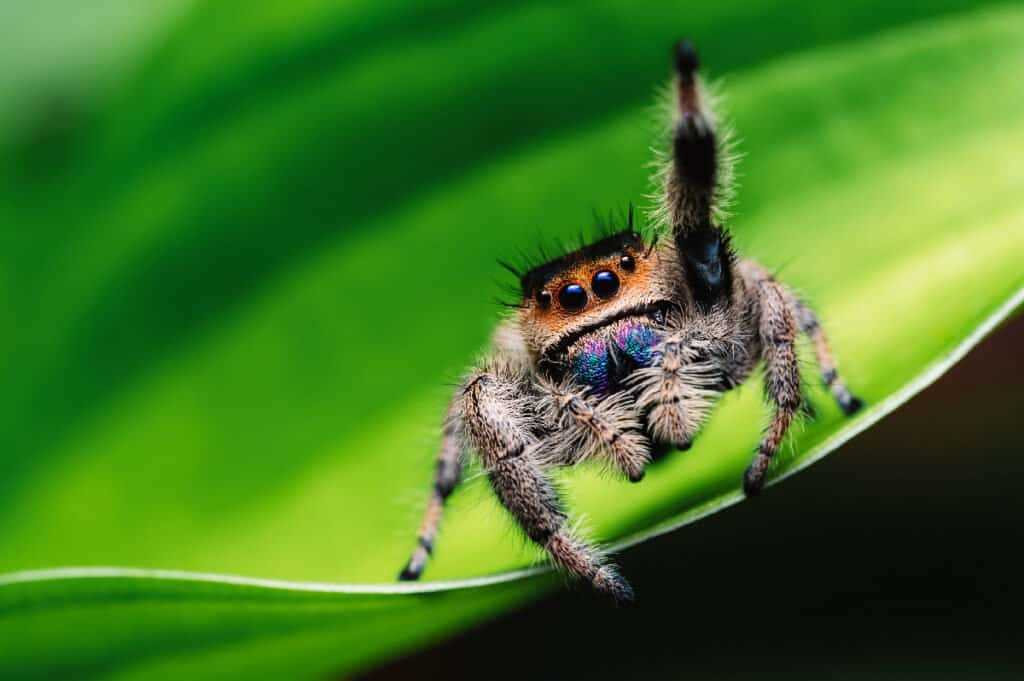
Optimal conditions, such as a warm and moist environment, can promote faster growth and more frequent molts. This can result in larger adult spiders. On the other hand, unfavorable conditions may slow down the growth rate and extend the time between molts, resulting in smaller individuals.
Largest Recorded Regal Jumping Spider
The regal jumping spider is known for its impressive size, among other unique characteristics. While most jumping spiders are relatively small, the regal jumping spider stands out as one of the largest species in the jumping spider family, the Salticidae.
The size of regal jumping spiders can vary depending on several factors, including their habitat, diet, and gender. However, the largest recorded regal jumping spider to date reached an impressive size of approximately 2 inches (5 centimeters), including its legs.
The regal jumping spider gets its name from its majestic appearance. It has a regal and vibrant coloring, with a combination of metallic greens, blues, and purples on its body. This colorful display is believed to serve as a warning to potential predators, signaling that the spider may be toxic or dangerous.
The size of the regal jumping spider is greatly influenced by its habitat. These spiders are commonly found in tropical rainforests and other densely vegetated areas, where they have ample opportunities to hunt and mate. The abundance of food in their habitat allows them to grow larger compared to their counterparts in less favorable environments.
The large size of the regal jumping spider also contributes to its hunting abilities. With its larger body and longer legs, it is able to capture larger prey and cover more ground while searching for food. This gives the regal jumping spider a significant evolutionary advantage over smaller spider species, allowing it to thrive in its environment.
Male vs Female Regal Jumping Spider Size
One interesting aspect of regal jumping spiders is the difference in size between males and females. In many spider species, females are typically larger than males, but with regal jumping spiders, the opposite holds true. Male regal jumping spiders are usually larger in size compared to their female counterparts.
Size dimorphism is a common phenomenon among various arachnid species, and regal jumping spiders are no exception. This size difference between males and females is attributed to their distinct roles in reproduction and hunting strategies.
On the other hand, female regal jumping spiders have different priorities. Their primary focus is on producing and protecting their eggs. Being smaller in size allows them to be more agile and elusive, making it easier for them to navigate their habitat and catch prey.
The Role of Habitat in Size Difference
The difference in size between male and female regal jumping spiders can also be influenced by their habitat. Different habitats provide varying resources, such as prey availability and shelter, which can affect the growth and development of the spiders.
For example, a habitat rich in insect prey can provide ample food resources for regal jumping spiders, allowing them to grow larger in size. Conversely, a habitat with limited prey availability may result in smaller spiders.
Additionally, the availability of suitable shelter can also impact spider size. Spiders that have access to a variety of hiding spots and protective structures may be able to grow larger because they have a lower risk of predation.
Size Comparison with Other Jumping Spider Species
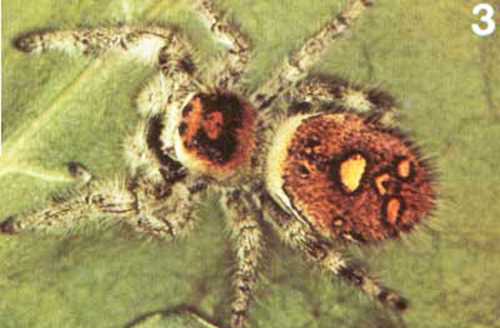
The regal jumping spider is considered to be one of the larger species of jumping spiders. On average, these spiders can measure anywhere between 10mm to 18mm in length. Their size, combined with their vibrant colors and unique patterns, make them a captivating sight.
In contrast, other jumping spider species may have a smaller size range. Some smaller species may only reach lengths of around 5mm to 10mm, while larger species can measure up to 15mm in length. These size variations highlight the diversity and range of sizes that jumping spiders can exhibit.
Another aspect to consider when comparing the size of jumping spider species is their leg span. The regal jumping spider typically has a leg span that is proportionate to its body size, giving them an agile and nimble advantage when hunting or navigating their habitat.
Overall, while the regal jumping spider may not be the largest jumping spider species, its size is still significant in comparison to other members of its family. The combination of its size, colors, and habitat makes the regal jumping spider an intriguing and beautiful arachnid to observe.
The Influence of Habitat on Regal Jumping Spider Size
The regal jumping spider can be found in a wide range of habitats, including forests, fields, gardens, and even urban areas. The availability of food sources, shelter, and other environmental conditions can have a significant impact on their growth and development.
In general, regal jumping spiders that live in areas with abundant food resources tend to grow larger compared to those in areas with limited resources. This is because a well-fed spider has more energy and nutrients available for growth. Additionally, a larger body size can provide survival advantages, such as increased agility and hunting capabilities.
Another factor that can influence the size of regal jumping spiders is the presence of predators. In habitats with a high density of predators, such as birds and other spiders, the regal jumping spiders may have a smaller body size as a survival strategy. Being smaller in size can help them avoid being detected and consumed by their predators.
The colors and patterns of the regal jumping spiders can also be influenced by their habitat. In some cases, these spiders may exhibit different color variations depending on the specific environment they inhabit. This adaptive coloration can help them blend in with their surroundings and increase their chances of catching prey or avoiding predators.
The Growth Patterns in Regal Jumping Spiders
Size plays a crucial role in the life of a regal jumping spider.
As regal jumping spiders start their lives as tiny hatchlings, they go through various molting stages to reach adulthood. During each molting stage, they shed their exoskeleton and emerge larger in size.
The growth rate of regal jumping spiders is influenced by multiple factors, including their habitat, nutrition availability, and temperature. In favorable conditions, these spiders tend to grow faster and reach larger sizes.
Their size also affects their hunting strategies. Smaller regal jumping spiders tend to rely on stealth and camouflage to sneak up on their insect prey. On the other hand, larger spiders have the advantage of being able to overpower larger insects and rely less on camouflage.
Another fascinating aspect of regal jumping spider size is the variation in colors and patterns of their bodies. Larger spiders usually have more vibrant and striking colors, which serve as both a defense mechanism and a display of their fitness to potential mates.
Studying the growth patterns in regal jumping spiders provides valuable insights into their biology and behavior. It helps researchers understand how they adapt to different habitats and how their size influences their survival and reproductive success.
Relationship Between Body Size and Hunting Abilities
The regal jumping spider, known for its vibrant colors and agile nature, possesses a body size that plays a crucial role in its hunting abilities. These arachnids have adapted to their environment by developing a size that optimizes their predatory skills.
One of the factors that influence the hunting abilities of regal jumping spiders is their size. Larger spiders generally have longer legs, allowing them to cover greater distances and move more swiftly. This gives them an advantage when ambushing their prey.
Furthermore, research has shown that larger regal jumping spiders have better vision. Their larger eyes provide enhanced depth perception, allowing them to accurately judge distances and make precise leaps towards their prey. This visual acuity gives them an edge when hunting in complex environments, such as dense vegetation or cluttered surfaces.
However, there is a limit to how large a regal jumping spider can grow. At a certain size, their agility may be compromised, making it more difficult to maneuver and catch prey. Additionally, larger bodies require more energy to sustain, which could make hunting less efficient.
The importance of body size in the hunting abilities of regal jumping spiders cannot be overstated. Their size, specifically their leg length and body dimensions, plays a significant role in their ability to capture prey and survive in their natural habitat.
The Evolutionary Advantages of Different Sizes in Regal Jumping Spiders
Size plays a crucial role in the survival and evolution of species, and the regal jumping spider (Phidippus regius) is no exception. These fascinating arachnids exhibit a wide range of sizes, each with its own set of advantages and disadvantages.
1. Hunting Capabilities: The size of a regal jumping spider directly affects its hunting abilities. Larger spiders have a greater capacity to capture larger prey, such as insects, due to their increased strength and agility. On the other hand, smaller spiders excel at hunting smaller prey, utilizing their smaller bodies and faster movements to their advantage.
2. Mating Success: In many spider species, including the regal jumping spider, larger males often have a higher chance of mating success. Female spiders are typically larger than males, and the size discrepancy may play a role in determining the most suitable potential mate. Larger males may have a competitive advantage in attracting and successfully mating with females.
3. Territorial Dominance: Size can also influence the ability of regal jumping spiders to establish and defend territories. Larger spiders may have the advantage of claiming larger areas and fending off smaller, competing spiders. Their size can be an intimidating factor, acting as a deterrent against potential rivals.
4. Predator Avoidance: Despite their impressive hunting skills, regal jumping spiders are still vulnerable to predation. Larger spiders may have a better chance of survival due to their size, which helps them appear more intimidating to potential predators. Additionally, their larger size may make it more difficult for predators to swallow them whole.
5. Reproductive Fitness: Size can also impact the reproductive fitness of regal jumping spiders. Larger females generally produce more offspring and have a higher chance of successful reproduction. Their larger bodies can accommodate a greater number of eggs and ensure the survival of more spiderlings.
6. Species Survival: Variation in size within a species like the regal jumping spider can promote species survival. Different sizes may be advantageous in different habitats or ecological niches. This diversity can increase the chances of species adaptation and persistence, allowing the regal jumping spider to thrive in various environments.
Overall, the diverse sizes found within the regal jumping spider population highlight the adaptability and evolutionary success of this species. Whether it’s hunting, mating, defending territories, avoiding predators, or ensuring reproductive fitness, size plays a crucial role in the survival and prosperity of these impressive arachnids.
Insights from Studying Regal Jumping Spider Size
Additionally, studying the size of regal jumping spiders can provide valuable comparative data. By comparing their sizes to other jumping spider species, researchers can gain insights into the unique characteristics and adaptations of these spiders. This comparative analysis can offer valuable information on the evolutionary history and diversification of jumping spiders.

I’m Lena Adams—a product of an unconventional upbringing in the African wilderness. My father, a daring explorer of African wildlife, sparked my fascination with reptiles, a passion that intertwined with the tragic loss of my mother during an expedition, leaving an indelible mark on my life. Driven to understand the creatures that captivated my parents, I embarked on my journey, sharing insights about reptiles, frogs, and lizards on my website. Through my explorations and conservation efforts, I honour my family’s legacy while seeking connections—to the creatures, nature, and the mother whose presence I yearn to understand.
